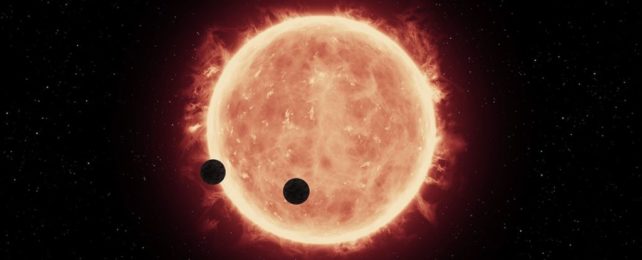A red dwarf star just 105 light-years away may be hosting at least one habitable world.
In close orbit around the cool, dim star, scientists have found and confirmed two rocky exoplanets – one comfortably at a distance range to the star known as the habitable zone.
Follow-up observations will need to be made to further determine its nature, but the discovery is an exciting one, suggesting that more such worlds may be waiting to be discovered in the solar neighborhood.
Even if the exoplanet isn't habitable, worlds in the habitable zone are relatively rare, especially rocky ones.
So, either way, the discovery is an important data point for characterizing the population of these exoplanets.
The two exoplanets were discovered as a result of observations from NASA's TESS exoplanet-hunting telescope.
As it stared at a small red dwarf star named LP 890-9 (AKA TOI-4306), it picked up the faint, regular dips in starlight characteristic of an exoplanet orbiting between us and the star, passages known as transits, on a 2.7-day period.
Transit data can tell us a fair bit about an exoplanet. There's the fact of its existence, for one. Then there's the orbital period. And, based on how much the starlight dims, scientists can also infer the diameter of the exoplanet.
But, in order to confirm the detection, and obtain more data on the exoplanets, more observations are required using different instruments.
"This follow-up," explains astronomer Laetitia Delrez of the University of Liège in Belgium, "is particularly important in the case of relatively cold stars, such as TOI-4306, which emit most of their light in the near-infrared and for which TESS has a rather limited sensitivity.'
She and her team employed the telescopes of the SPECULOOS (Search for habitable Planets EClipsing ULtra-cOOl Stars) consortium, sensitive to the near-infrared wavelengths emitted by TOI-4306. The transit data obtained in these observations confirmed the existence of the exoplanet, named LP 890-9b.
Then the team looked for exoplanets that may have been missed by TESS – and found a second world, slightly more distant from the star than LP 890-9b. This exoplanet, named LP 890-9c, has an orbital period of 8.4 days.
Other data, including radial velocity measurements that determine the gravitational pull an exoplanet exerts on a star and thus derive their mass, allowed the team to characterize the two exoplanets in detail.
Although the two masses have not been measured, the radial velocity data gave the scientists an upper mass limit for both exoplanets.
LP 890-9b is about 1.32 times the diameter of Earth, and up to 13 times its mass.
LP 890-9c is about 1.37 times the diameter of Earth, and up to 25 times its mass.
These measurements are consistent with the density of rocky worlds, like Earth, Mars, and Venus, rather than gaseous or icy worlds like Jupiter or Neptune.
This means the exoplanets can be classified as super-Earths – rocky worlds that are larger than Earth, and smaller than Neptune.
Where they are orbiting the star – in particular, the outer exoplanet, LP 890-9c – is where it gets interesting.
This is one of the first things scientists look for in assessing the potential habitability of an alien world. An exoplanet too close or too far from its star is going to be too hot or too cold, respectively, for life as we know it.
But there's a temperate, or habitable, zone in every star's orbital vicinity in which liquid water could comfortably sit on a planetary surface.
LP 890-9c may be on a close orbit to its star compared to Earth, but that star is much, much cooler and dimmer than the Sun.
At its orbital position, the exoplanet sits within its star's conservative habitable zone, receiving similar stellar radiation levels to Earth.
After the TRAPPIST system, it's the second-most promising potentially habitable world discovered yet, the researchers said.
"But we should not get ahead of ourselves. Being in the right spot does not guarantee a palm beach," says astronomer Robert Wells of the University of Bern in Germany.
"Our neighbor planet Venus, which is, so to speak, a carbon dioxide-rich, near 500-degrees-Celsius pressure cooker, is also near this so-called habitable zone around the Sun."
LP 890-9c is very close to the point at which a young planet might be caught in a runaway greenhouse effect, like Venus, but we don't know for sure what's going on out there.
A second team of scientists, including some of the authors on the LP 890-9 paper, has already submitted a preprint interrogating this mystery, but we likely won't know until we obtain observations of the exoplanet's atmosphere, if it has one.
The James Webb Space Telescope is already proving adept at this. The telescope, as you can imagine, is in high demand, so we might have to wait some time for observations.
On the other hand, a target as promising as LP 890-9c may warrant a hustle, since whatever the outcome, we have something to learn from it.
"It is important," says astronomer Amaury Triaud of the University of Birmingham in the UK, "to detect as many temperate terrestrial worlds as possible to study the diversity of exoplanet climates, and eventually to be in a position to measure how frequently biology has emerged in the Cosmos."
The research has been published in Astronomy & Astrophysics.
